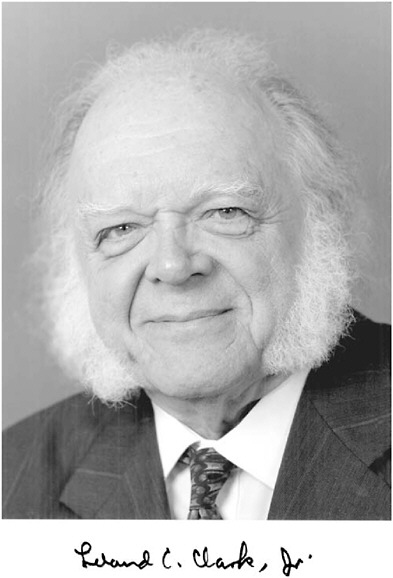LELAND C. CLARK JR.
1918–2005
Elected in 1995
“For inventions and contributions covering biosensors, artificial organs and blood, and their medical applications worldwide.”
BY HARDY W. TROLANDER
LELAND C. CLARK JR., retired vice president of Synthetic Blood International, died at the home of his daughter, Rebecca, in Cincinnati, Ohio, on September 25, 2005. He was 86 years old.
Clark was born on December 4, 1918, in Rochester, New York, and attended elementary and secondary schools in Attica, New York. A marginal student, he surprised everyone, including himself, by getting a perfect score in science on what was the first administration of the Regents Exam in New York State. From that moment on, he applied himself fully with a clear view of his goal. After high school, he attended the co-op program at Antioch College, from which he graduated in 1941 with a B.S. in chemistry. This was followed by a National Research Council Fellowship at the University of Rochester, which led to a Ph.D. in biochemistry and physiology, awarded in 1944.
Clark then returned to Antioch to become an assistant professor of biochemistry and chairman of the Biochemistry Department in the Fels Institute on the Antioch campus. In essence, he founded the department and remained its head until 1958. From 1955 to 1958, he was also a senior research associate in pediatrics and surgery at the University of Cincinnati College of Medicine, Cincinnati, Ohio.
In 1958, Clark left Ohio to become associate professor of biochemistry, Department of Surgery, University of Alabama Medical College, in Birmingham, Alabama. In 1961, he became professor of biochemistry, and he remained there until 1968. He then returned to Ohio and was named professor of research pediatrics at the Children’s Hospital Research Foundation in Cincinnati, a position he held until 1991. Clark was named University Distinguished Service Professor of the University of Cincinnati in 1984 and research professor of biological sciences at Antioch in 1991.
In 1992, Clark was a founder of Synthetic Blood International Inc., of San Diego, California, whose primary mission was to develop his earlier invention of a fluorocarbon-based artificial blood, safe for human use. As the company’s vice president of research and development, he conducted and oversaw the research in laboratories on the Antioch campus. One of Clark’s early contributions was a large-capacity, all-glass bubble-defoam oxygenator and pump, one of the earliest successful heart-lung machines.
Perhaps his major contribution was the invention of the Clark membrane oxygen electrode. The device was first reported in a landmark paper delivered on April 15, 1956, at a meeting of the American Society for Artificial Organs during the annual meetings of the Federated Societies for Experimental Biology. The importance of this invention was immediately recognized, and when the paper was published, it became one of the most often cited papers in the life sciences. The electrode, in its original form, has been in use throughout the world in a broad range of applications requiring precision measurement—for water quality, many medical and pharmacological situations, and food production.
Clark later envisioned a new form of polarographic sensor that used an enzymatic reaction to produce a polarographically measurable reaction product from an otherwise polarogaphically insensitive material. The first manifestation of this sensor was in the form of an electrode capable of instantaneous, very accurate measurement of glucose in human blood. Based on Clark’s electrode, a variety of enzyme electrodes were developed for a
multiplicity of medical, food processing, and environmental measurements.
Clearly, Clark’s vivid imagination and his ability to combine chemical, electrical, and mechanical principles led to the development of a wide range of devices, from large-scale heart-lung machines for human open-heart surgery to microelectrodes for making measurements within the human brain. His creative range was truly unique.
Clark was elected to membership in the National Academy of Engineering (NAE) in 1995 and was awarded the NAE Fritz J. and Dolores H. Russ Prize in 2005. His citation reads “For bioengineering membrane-based sensors in medical, food, and environmental applications.”
Clark’s many awards and honors include the NIH Research Career Award (1962); Distinguished Lecturer Award, American College of Chest Physicians (1975); Honorary Doctor of Science, University of Rochester School of Medicine and Dentistry (1984); Horace Mann Award for Service to Humanity, Antioch College (1984); Heyrovsky Award in Recognition of the Invention of the Membrane-Covered Polarographic Oxygen Electrode (1985); American Association for Clinical Chemistry Award for Outstanding Contributions to Clinical Chemistry (1989); American Heart Association Samuel Kaplan Visionary Award (1991); enshrinement into the Engineering and Science Hall of Fame (1991); Pharmacia Biosensor’s Sensational Contributions to the Advancement of Biosensor Technology Award (1992); and the Daniel Drake Award for Outstanding Achievements in Research, University of Cincinnati College of Medicine (1993).
In the 1970s, Lee Clark invited Fred Hoover (a successful inventor and NAE member) and me to his house for a demonstration. With a couple of wires, a meter and a battery at hand, Lee filled a glass with water and some sugar, connected everything up, and placed the wires in the liquid. He then added some glucose oxidase and immediately the meter indicated that a current was flowing between the two wires. I treasure the memory of that demonstration. It was typical Lee Clark, essentially simple yet conveying a powerful message—the first ever bioelectrode was clearly in the offing.
Dr. Clark was preceded in death in 1988 by his wife, Eleanor, who assisted him in his work throughout his career. Though not originally trained as a scientist, she was a very bright woman who learned not only the basic science, but also the intricacies of writing grant and patent applications.
He is survived by his daughter, Susan Clark Wooley, and granddaughter, Laura Wooley; daughter, Joan Tornow, son-in-law, John Tornow, and grandsons, Nick and Alex Tornow; daughter, Linda Noyes, son-in-law, Dave Noyes, and grandson, David Friend; daughter, Becky Clark, and grandson, Chris Gerrard; and younger brother, Woodums Clark. The Tornows live in Takoma, Washington, and the Wooleys, Noyes, and Clarks live in Cincinati, Ohio.







